Senior housing
Can we determine those most likely to move-in to Independent Living?
YES: We CAN determine those most likely to move in to Independent Living! Now, the next steps.
2018 Advanced Sales & Occupancy Summit for Senior Housing
Nov. 12-13, 2018 – Clearwater Beach, FL
Russell J. Watson, EdD – Russ@DrRussWatson.com
Presented in the honor and memory of
Anthony Mullen – 12/4/1956 – 3/10/2018
The story of the Mindset Metrics project.
The introduction of the Mindset Data project to the seniors housing industry happens this week. The research, testing, betas, and confirmation began in 2011-12. Tony Mullen asked if we could use the Mindset Metrics techniques to determine those most likely to move-in with a Rental I.L., versus those who remain cold leads. Watson developed a short-form survey of about two minutes in duration.
This is able to be taken in an easy paper-form or on-line as one wishes. The goal of the two-minute version was to capture the primary behavioral and motivation tendencies of the prospects and to match scores with the longer version assessment at a rate of about 75-80% accuracy. The result was that the brief survey identified the primary behavioral and motivational traits at a rate of 96% accuracy. We were ready. This became the core of Mindset Metrics.
What We’ve Learned
What Motivates those who Move-In? (What’s their WHY?)


Based on their common response patterns to the brief preference survey, several motivational traits emerge, (in order of intensity):
- They have an open, ‘giving,’ helpful attitude toward others; certainly for their family, and also for others in their new community. Those who are active may enjoy service projects on the property or in the greater community, there is a willingness to ‘give-back.’ (This is a strong differentiator between Move-Ins and Cold Leads.)
- They maintain a high drive for knowledge and enjoy continual learning. On-property library, field trips, and cultural enrichment may be of interest.
- They have a tendency toward ‘belonging’ rather than expressing their independence and uniqueness. They assimilate rather easily into the new community, and may join interest groups readily. (This is a strong differentiator between Move-Ins and Cold Leads.)
- There is a slight awareness / sensitivity to aesthetics. Two-fold here: Attraction to the aesthetics of the seniors’ community, and awareness of their inability to keep up with the aesthetics of their current home or property.
What Motivates those who remain Cold Leads? (What’s their WHY?)


- A drive to be self-reliant and independent. They want to take care of themselves, and they have a sense of uniqueness and independence that they want to maintain. (They may see moving into a seniors’ community as giving up on their self-reliance, uniqueness, and independence.
- A perceived need to protect their finances. This is a primary area of objection to moving in; even though the financial resources are available.
- A stronger drive for order and routine emerges as a primary motivator for the Cold Leads. They are secure when they have control of their time: For meals, taking walks, going to church, etc. They may see moving into a community as losing control of their order and routine.
- In general, there are four ‘Freedom’ motivators that continue to drive the Cold Leads. It is nevertheless important for the seniors housing community to consider that ‘No,’ might simply mean, ‘Not now,’ and continue to maintain contact and rapport with the Cold Leads.
The charts below show the results from the short-form survey data.
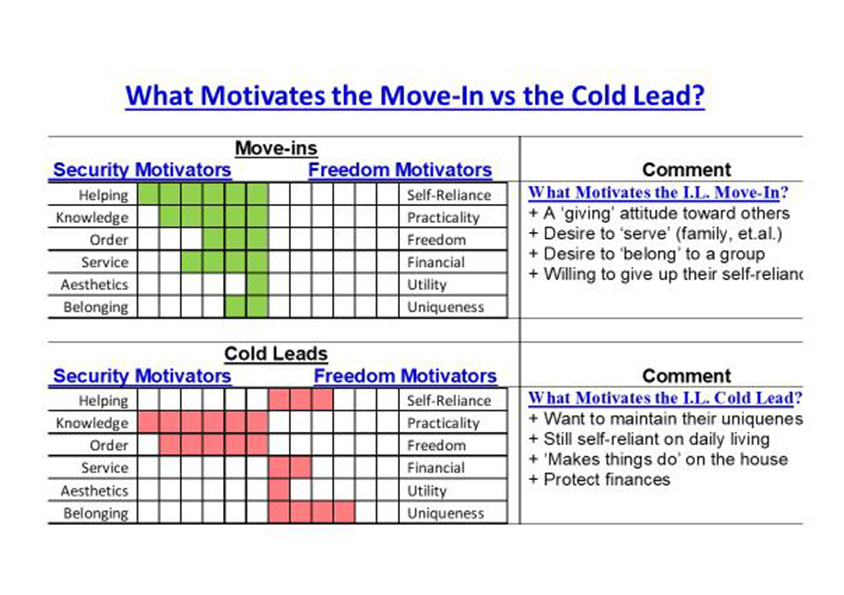
“Everything should be reduced to its simplest form, and no simpler.”
Einstein

Insight!! – It wasn’t until we reduced data to its simplest form that the primary differences between the Motivators of Move-Ins (above) versus Cold Leads (below) emerged so clearly. In brief, their motivators are nearly an opposite relationship. Note chart above vs the one below for an at-a-glance global view.
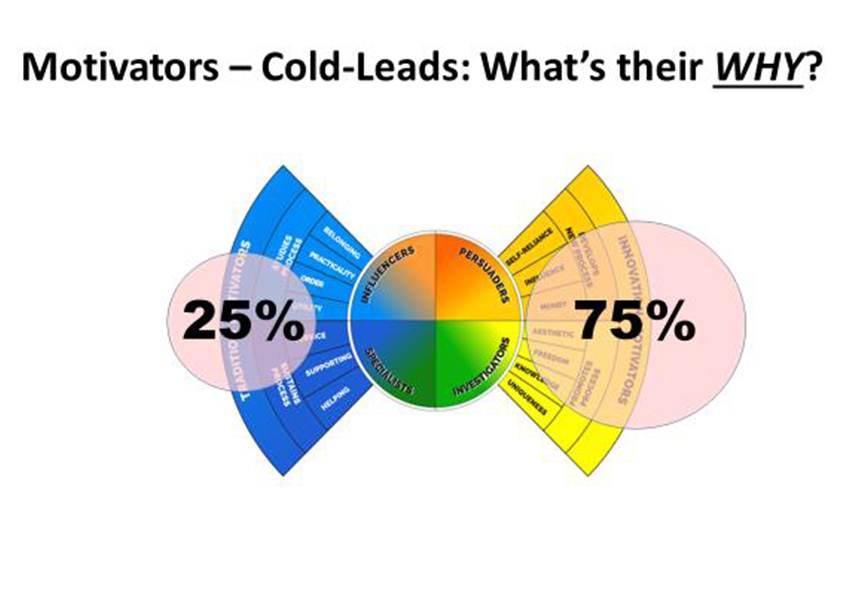
Do the behavioral styles differ between Move-Ins and Cold Leads, using the same simplified lens? Yes, and those differences are shown below.
What is the behavioral style of those who Move-In?

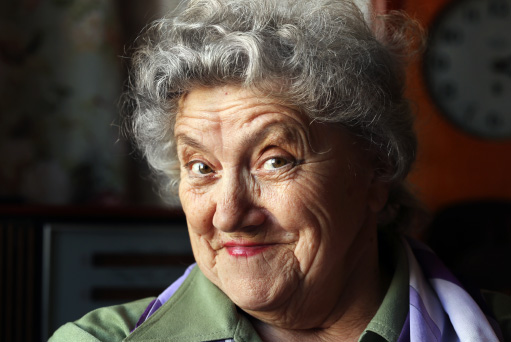
- Substantially more outgoing, talkative, and people-oriented than those who remain cold leads.
- They are good coach / counselor types, for each other, and even for the seniors housing salesperson.
- They tend to be more flexible and open to new alternatives than those who remain cold leads.
What is the behavioral style of those who remain Cold Leads?
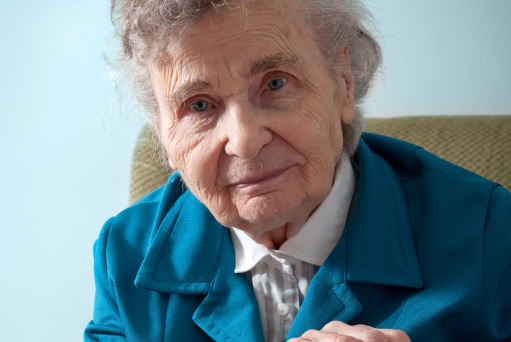

- They tend to be substantially more cautious (bordering on suspicious) than are those who move in.
- They are not as outgoing as those who move in, and are substantially more quiet and reflective.
- They are rather slow to make decisions; wanting to carefully weigh all alternatives. For some, not to decide is to decide. For others, it is important for the seniors housing salesperson to remain in contact and maintain rapport because ‘No,’ might simply mean ‘Not now.’
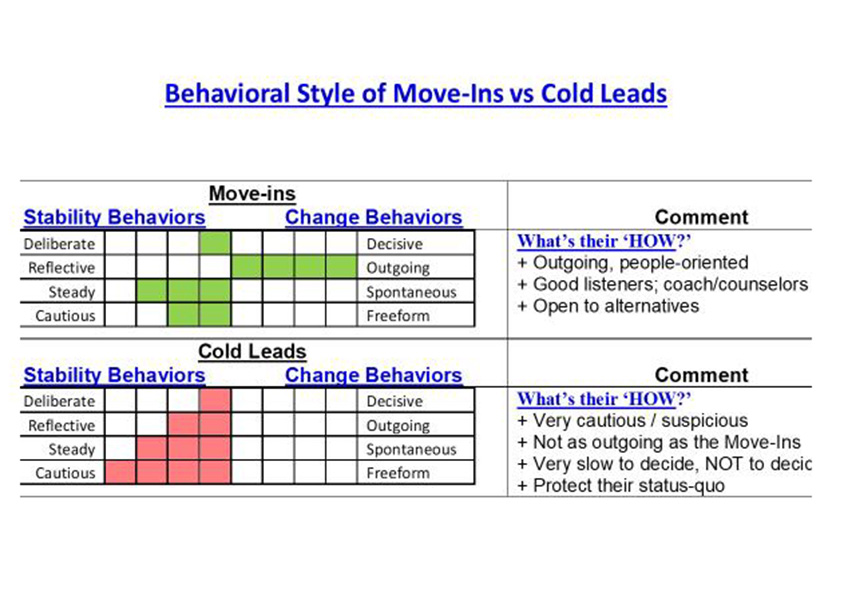
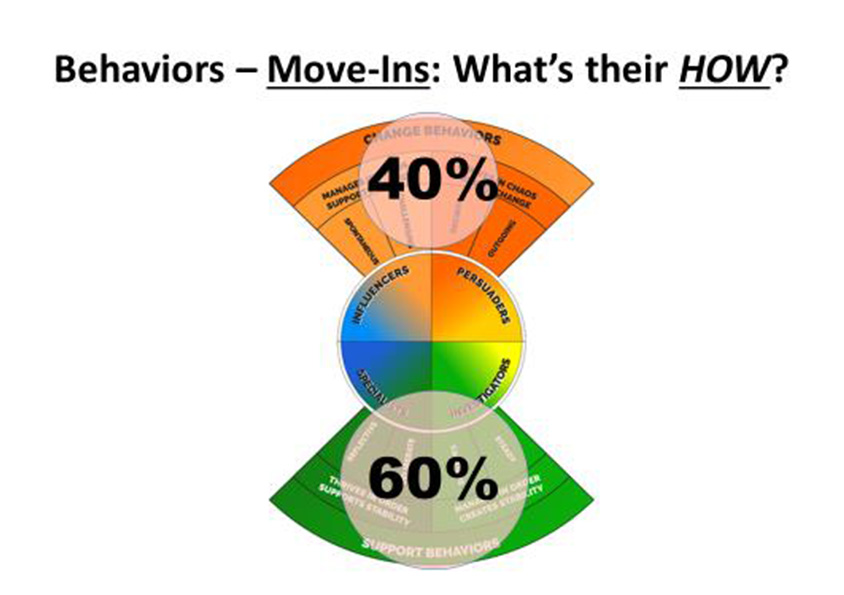
Insight!! – In looking at behavioral preferences with a simple lens we find that the Move-Ins show just enough of a change-oriented ‘nudge’ to carry them through the decision process to make the move. Namely, a nudge in the direction of a substantially stronger people-orientation for the Move-Ins.
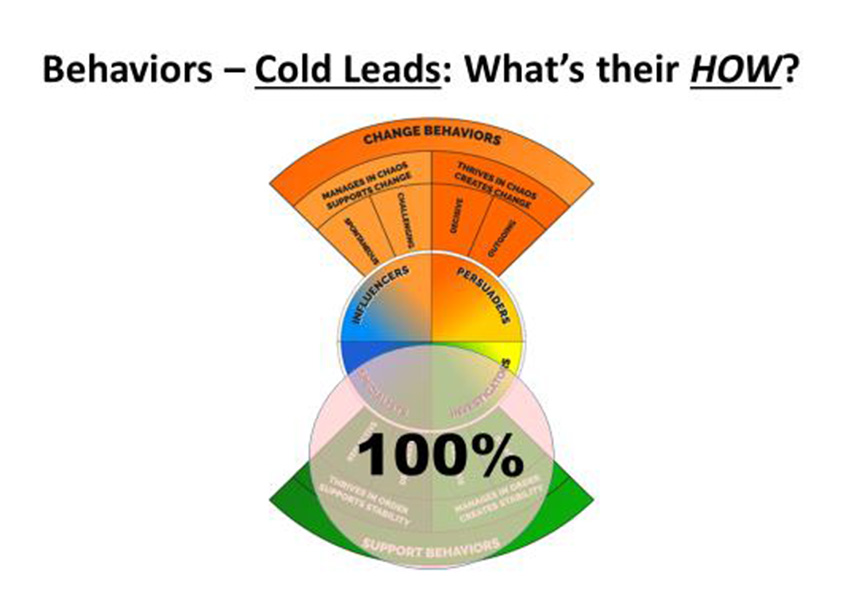
The cold leads remain in stability / security mode to the extent that they choose not to move in to the rental Independent Living community. Watson encourages the seniors housing communities to maintain contact with the cold leads, because as their situation changes there may be a ‘nudge’ to create a sense of urgency to make a change and move in.
(This paper is written in the honor and memory of Anthony Mullen, 1956-2018.)
This is an abbreviated summary. Register to request the full report.

